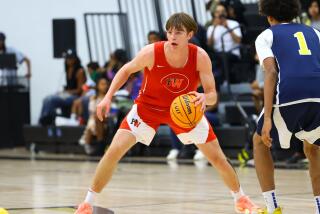‘You’re Safe Until 5:30’ : NYSP Gives Underprivileged Kids a Place to Go, Learn
SAN DIEGO — Until this summer, local children had very few choices as far as recreation programs were concerned.
One such program was a privately funded youth camp run last summer at Memorial Recreation Center in Southeast San Diego. More than 100 kids participated, but the area around Memorial is known more for its drug dealers than as a place where youths can escape the streets.
“Gangs would be out there selling (drugs),” said Michael Brunker, who was the program’s director. “They’d be coming through every hour on the half hour. Every day for 10 weeks.”
Brunker said he watched people in cars offer drugs to the children at Memorial.
“I’m afraid of going there,” said Guadalupe Estrada, 15. “I have to go right through them (drug dealers) to go to the gym.”
This summer, Estrada and more than 200 other children have an additional choice. The National Youth Sports Program is offering San Diego’s youth an alternative.
The NYSP, an expense-free alternative for underprivileged children between the ages of 10 and 16, is being conducted in San Diego for the first time. Its goal is to give kids an alternative to the streets, an opportunity to get them away from situations that involve gangs and drugs.
Brunker is the San Diego County Probation Department’s athletic director and activity director for the 25-day NYSP, which is continuing at San Diego City College until July 27. There are still places in the program available. (Information may be obtained by calling 231-9567.)
“If we don’t want the kids causing trouble, we have to provide them with a positive alternative,” said Dennis Kane, the San Diego High School basketball coach and one of 11 instructors working at NYSP. “We can’t tell them to say no to drugs and no to gangs and not give them anything positive to do.”
There are currently 250 children participating in the NYSP at San Diego City College. The national program is in its 20th year of providing disadvantaged youths the opportunity to participate in a variety of sports and enrichment programs.
“One good thing we are not exposed to here is to drugs and all those dope dealers,” Estrada said, comparing the NYSP and the daily regimen at Memorial. “The good thing about last year (Memorial) is none of the kids got hassled that I heard of. There’s no gangs around here. All you have to do is worry about getting on the bus to come here, and you’re safe until 5:30. That’s a good thing.”
The NYSP is co-sponsored by San Diego City College and the San Diego Police Department and is part of a plan in which Police Athletic Leagues (PAL) will be introduced in the fall to provide organized sports for children.
“This is for the people in the trenches,” Brunker said. “I was only there (Memorial) for 10 weeks, but there are people who have been down in those kind of rec centers and areas for years. We’re doing this (NYSP) for them. PAL is for them.”
The NYSP requires that 90% of its applicants meet income guidelines, because federal funding dictates that that percentage be economically disadvantaged. The guidelines are adjusted according to family size. The ceiling, for example, is an $11,650 annual income for a family of four, $19,400 for a family of eight.
“There’s a big need out in San Diego to provided this type of program,” John Clancy said. Clancy, 57, is the dean of instructional support at San Diego City College and the program’s administrator. “Society today is all so concerned with gangs. You have to give youth active things to do. A lot of them have nothing to do.”
Archie Robinson, 13, said, “Most of (the kids) just play on the streets with their friends. Now they have a chance to meet more people, and they don’t have to pay or anything, so that’s great.”
Last year, 135 colleges and universities in 40 states played host to NYSP programs. NYSP is a partnership that brings together the federal government--represented by the Dept. of Health and Human Services--and the nation’s colleges and universities acting through the National Collegiate Athletic Assn.
In the summer of 1968, representatives of the NCAA and the President’s Council on Physical Fitness piloted the program at two universities’ athletic facilities. In March 1969, the White House announced a $3-million commitment by the federal government to establish a sports program for economically disadvantaged children. The federal grant has since doubled, and there remains strong congressional support for NYS program’s objectives.
“This is not a recreation program as many programs are where you play games,” Clancy said. “The purpose of the program is to give disadvantaged youth the opportunity for structured sports and enrichment.”
Sports taught include swimming, softball, racquetball, tennis, basketball, football, golf, track and field, volleyball and soccer. The enrichment programs feature lectures on drug and alcohol abuse, health and fitness and field trips to various sites around San Diego County, many of which are provided to the program free of charge.
“I think there’s a need for it,” said Brunker, 36. “(A need) not only in San Diego, but across the country, because these kids today aren’t getting this kind of direction like we did when we came up.”
Brunker, who at 16 participated in the NYSP program in Detroit and later came back to coach, is responsible for recruiting a majority of the kids for the San Diego program by contacting youth service agencies and other community-based programs.
Clancy said Brunker, who spent 17 years as an assistant basketball coach at the University of Detroit, with the Detroit Pistons and at San Diego State, is the person most responsible for bringing the NYSP to San Diego.
The County Board of Supervisors and the San Diego City Council’s board of directors approved creating the position of an athletic director for the probation department and the NYSP itself. The City Council also approved the use of police-confiscated drug money--25% of which is to go to youth diversion programs--for the NYSP.
The police department also committed personnel in the form of Sgt. Dave Kruk, who is the executive director of the PAL.
In order for Brunker to attain the $38,000 grant from the NCAA, he needed to locate a college or junior college campus on which to hold it. Jeanne Atherton, San Diego City College president, thought it a worthwhile project and gave it her approval.
Clancy became the college’s personnel contribution. Brunker estimates SDCC’s financial contribution for personnel and facility use at $65,000. He said what SDCC gets in return is “exposure of the institution to the community. They are directly servicing the youth of the community.”
Of the $38,000 grant, approximately $27,000 will go to pay the salaries of a total of 17 instructors and aides. The remainder will be spent on supplies, for use of the swimming pool at the downtown YWCA and transportation.
The program provides bus and trolley passes for all participants. Another $20,000 from the U.S. Department of Agriculture was received for the cost of hot lunches and snacks, which are provided on each of the program’s 25 days. Other contributions and private donations produced a total budget of close to $200,000.
The NYSP also provided a mandatory physical examination for each participant. The physicals were provided by Harbor View Medical Center. Some of the children seen by Meg Norton, a nurse and administrator at Harbor View, and a staff of six physicians, six nurses and other volunteers, had medical needs.
“We saw one little boy, 11 or 12, who came in and couldn’t see,” she said. “He had very, very poor eyesight.”
Norton said the medical center provided glasses for the boy.
NYSP instructors include Ron Davis, Morse High basketball coach; Jim Wright, a tennis instructor at San Diego City College; Garry Wooten, a Southern California karate champion; Jan Martin, San Diego State assistant women’s basketball coach, and Tony Williams, SDCC football coach, who also runs the enrichment programs.
Among the aides are Willie Davis, a recent Morse High graduate who plans to play basketball at U.S. International next season; Bryant Moore, a recent Madison High graduate who plans to play basketball at Mesa (Ariz.) College, and Liza Carrillo, who plays basketball at Palomar College. Brunker said he hopes some of the current participants can return as aides when they are too old for the program.
Brunker said that although he misses coaching the likes of Michael Cage, the instruction at the NYSP is the purest form of coaching.
“I get as much thrill out of watching these kids make their basket as I do watching Michael Cage score 40 points when he was at San Diego State,” Brunker said, sitting on a bench in the SDCC gym, where Davis patiently took a group of 10-year-olds through dribbling drills.
“I think this is where the real coaching is done. All the coaches that put the ball in these kids’ hands for the first time, they are the real coaches. And this is what we got to get back to, getting the influence to these youngsters now that a work ethic is important, that it’s valuable.”
Like most coaches, it is the potential product that drives them to work harder, and that is the reason most are at NYSP.
“Now these kids are 10 years old,” Brunker said. “I know eight years from now they can get scholarships to college.
“This is what I’m interested in doing. I want to see these kids make it. I want to see rich kids, poor kids, minority kids, white kids, black kids, whatever, go on and continue to do what they have to do to reach the next level of competition. And if sports is going to be their meal ticket, I don’t see a problem with it at all.”
More to Read
Sign up for Essential California
The most important California stories and recommendations in your inbox every morning.
You may occasionally receive promotional content from the Los Angeles Times.









